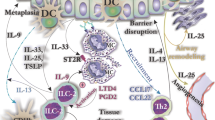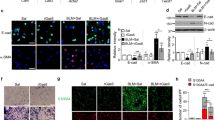Abstract
Objective
This study aims to investigate the role of protease-activated receptor (PAR) 2 and mast cell (MC) tryptase in LPS-induced lung inflammation and neutrophil recruitment in the lungs of C57BL/6 mice.
Methods
C57BL/6 mice were pretreated with the PAR2 antagonist ENMD-1068, compound 48/80 or aprotinin prior to intranasal instillation of MC tryptase or LPS. Blood leukocytes, C-X-C motif chemokine ligand (CXCL) 1 production leukocytes recovered from bronchoalveolar lavage fluid (BALF), and histopathological analysis of the lung were evaluated 4 h later. Furthermore, we performed experiments to determine intracellular calcium signaling in RAW 264.7 cells stimulated with LPS in the presence or absence of a protease inhibitor cocktail or ENMD-1068 and evaluated PAR2 expression in the lungs of LPS-treated mice.
Results
Pharmacological blockade of PAR2 or inhibition of proteases reduced neutrophils recovered in BALF and LPS-induced calcium signaling. PAR2 blockade impaired LPS-induced lung inflammation, PAR2 expression in the lung and CXCL1 release in BALF, and increased circulating blood neutrophils. Intranasal instillation of MC tryptase increased the number of neutrophils recovered in BALF, and MC depletion with compound 48/80 impaired LPS-induced neutrophil migration.
Conclusion
Our study provides, for the first time, evidence of a pivotal role for MCs and MC tryptase in neutrophil migration, lung inflammation and macrophage activation triggered by LPS, by a mechanism dependent on PAR2 activation.






Similar content being viewed by others
Change history
07 August 2020
The original article can be found online.
References
Aghasafari P, George U, Pidaparti R. A review of inflammatory mechanism in airway diseases. Inflamm Res. 2019;68:59–74.
Petri B, Sanz MJ. Neutrophil chemotaxis. Cell Tissue Res. 2018;371:425–36.
Amulic B, Cazalet C, Hayes GL, Metzler KD, Zychlinsky A. Neutrophil function: from mechanisms to disease. Annu Rev Immunol. 2012;30:459–89.
Weiss SJ. Tissue destruction by neutrophils. N Engl J Med. 1989;320:365–76.
Hollenberg MD, Compton SJ. International union of pharmacology. XXVIII proteinase-activated receptors. Pharmacol. Rev. 2002;54:203–17.
Vu TK, Hung DT, Wheaton VI, Coughlin SR. Molecular cloning of a functional thrombin receptor reveals a novel proteolytic mechanism of receptor activation. Cell. 1991;64:1057–68.
Rallabhandi P, Nhu QM, Toshchakov VY, Piao W, Medvedev AE, Hollenberg MD, et al. Analysis of proteinase-activated receptor 2 and TLR4 signal transduction: a novel paradigm for receptor cooperativity. J Biol Chem. 2008;283:24314–25.
Cicala C. Protease activated receptor 2 and the cardiovascular system. Br J Pharmacol. 2002;135:14–20.
Kawabata A, Kuroda R, Minami T, Kataoka K, Taneda M. Increased vascular permeability by a specific agonist of protease-activated receptor-2 in rat hindpaw. Br J Pharmacol. 1998;125:419–22.
Vergnolle N. Review article: proteinase-activated receptors—novel signals for gastrointestinal pathophysiology. Aliment PharmacolTher. 2000;14:257–66.
Cocks TM, Moffatt JD. Protease-activated receptor-2 (PAR2) in the airways. Pulm Pharmacol Ther. 2001;14:183–91.
Agier J, Pastwińska J, Brzezińska-Błaszczyk E. An overview of mast cell pattern recognition receptors. Inflamm Res. 2018;67:737–46.
González-de-Olano D, Álvarez-Twose I. Mast cells as key players in allergy and inflammation. J Investig Allergol Clin Immunol. 2018;28:365–78.
Agier J, Żelechowska P, Kozłowska E, Brzezińska-Błaszczyk E. Expression of surface and intracellular Toll-like receptors by mature mast cells. Cent Eur J Immunol. 2016;41:333–8.
Di Nardo A, Vitiello A, Gallo RL. Mast cell antimicrobial activity is mediated by expression of cathelicidin antimicrobial peptide. J Immunol. 2003;170:2274–8.
Di Nardo A, Yamasaki K, Dorschner RA, Lai Y, Gallo RL. Mast cell cathelicidin antimicrobial peptide prevents invasive group A Streptococcus infection of the skin. J Immunol. 2008;180:7565–73.
Shpacovitch VM, Seeliger S, Huber-Lang M, Balkow S, Feld M, Hollenberg MD, et al. Agonists of proteinase-activated receptor-2 affect transendothelial migration and apoptosis of human neutrophils. Exp Dermatol. 2007;16:799–806.
Rothmeier AS, Ruf W. Protease-activated receptor 2 signaling in inflammation. Semin Immunopathol. 2012;34:133–49.
Van den Boogaard FE, Brands X, Duitman J, de Stoppelaar SF, Borensztajn KS, Roelofs JJTH, et al. Protease-activated receptor 2 facilitates bacterial dissemination in pneumococcal pneumonia. J Infect Dis. 2018;217:1462–71.
Howells GL, Macey MG, Chinni C, Hou L, Fox MT, Harriott P, et al. Proteinase-activated receptor-2: expression by human neutrophils. J Cell Sci. 1997;110:881–7.
Roche N, Stirling RG, Lim S, Oliver BG, Oates T, Jazrawi E, et al. Effect of acute and chronic inflammatory stimuli on expression of protease-activated receptors 1 and 2 in alveolar macrophages. J Allergy Clin Immunol. 2003;111:367–73.
Shpacovitch VM, Feld M, Holzinger D, Kido M, Hollenberg MD, Levi-Schaffer F, et al. Role of proteinase-activated receptor-2 in anti-bacterial and immunomodulatory effects of interferon-γ on human neutrophils and monocytes. Immunology. 2011;133:329–39.
Klein A, Talvani A, Silva PM, Martins MA, Wells TN, Proudfoot A, et al. Stem cell factor-induced leukotriene B4 production cooperates with eotaxin to mediate the recruitment of eosinophils during allergic pleurisy in mice. J Immunol. 2001;167:524–31.
Horvat JC, Beagley KW, Wade MA, Preston JA, Hansbro NG, Hickey DK, et al. Neonatal chlamydial infection induces mixed T-cell responses that drive allergic airway disease. Am J Respir Crit Care Med. 2007;176:556–64.
Garcia CC, Russo RC, Guabiraba R, Fagundes CT, Polidoro RB, Tavares LP, et al. Platelet-activating factor receptor plays a role in lung injury and death caused by influenza A in mice. PLoS Pathog. 2010;6:e1001171.
Parasuraman S, Raveendran R, Kesavan R. Blood sample collection in small laboratory animals. J Pharmacol Pharmacother. 2010;1:87–93.
Su YC, Wu WM, Wu MF, Chiang BL. A model of chronic lymphocytic leukemia with Ritcher’s transformation in severe combined immunodeficiency mice. Exp Hematol. 2001;29:1218–25.
Schlosser SF, Burgstahler AD, Nathanson MH. Isolated rat hepatocytes can signal to other hepatocytes and bile duct cells by release of nucleotides. Proc Natl Acad Sci USA. 1996;93:9948–53.
Leite MF, Thrower EC, Echevarria W, Koulen P, Hirata K, Bennett AM, et al. Nuclear and cytosolic calcium are regulated independently. Proc Natl Acad Sci USA. 2003;100:2975–80.
Di Rosa M, Giroud JP, Willoughby DA. Studies on the mediators of the acute inflammatory response induced in rats in different sites by carrageenan and turpentine. J Pathol. 1971;104:15–29.
Ramos CD, Heluy-Neto NE, Ribeiro RA, Ferreira SH, Cunha FQ. Neutrophil migration induced by IL-8-activated mast cells is mediated by CINC-1. Cytokine. 2003;21:214–23.
Schmidlin F, Amadesi S, Dabbagh K, Lewis DE, Knott P, Bunnett NW, et al. Protease-activated receptor 2 mediates eosinophil infiltration and hyperreactivity in allergic inflammation of the airway. J Immunol. 2002;169:5315–21.
Davidson CE, Asaduzzaman M, Arizmendi NG, Polley D, Wu Y, Gordon JR, et al. Proteinase-activated receptor-2 activation participates in allergic sensitization to house dust mite allergens in a murine model. Clin Exp Allergy. 2013;43:1274–85.
de Boer JD, Van'tVeer C, Stroo I, van der Meer AJ, de Vos AF, van der Zee JS, et al. Protease-activated receptor-2 deficient mice have reduced house dust mite-evoked allergic lung inflammation. Innate Immun. 2014;20:618–25.
Asaduzzaman M, Nadeem A, Arizmendi N, Davidson C, Nichols HL, Abel M, et al. Functional inhibition of PAR2 alleviates allergen-induced airway hyperresponsiveness and inflammation. Clin Exp Allergy. 2015;45:1844–55.
Williams JC, Lee RD, Doerschuk CM, Mackman N. Effect of PAR-2 deficiency in mice on KC expression after intratracheal LPS administration. J Signal Transduct. 2011;2011:415195.
Pejler G, Ronnberg E, Waern I, Wernersson S. Mast cell proteases: multifaceted regulators of inflammatory disease. Blood. 2010;115:4981–90.
Compton SJ, Cairns JA, Holgate ST, Walls AF. The role of mast cell tryptase in regulating endothelial cell proliferation, cytokine release, and adhesion molecule expression: tryptase induces expression of mRNA for IL-1 beta and IL-8 and stimulates the selective release of IL-8 from human umbilical vein endothelial cells. J Immunol. 1998;161:1939–46.
He S, Peng Q, Walls AF. Potent induction of a neutrophil and eosinophil-rich infiltrate in vivo by human mast cell tryptase: selective enhancement of eosinophil recruitment by histamine. J Immunol. 1997;159:6216–25.
Schmidlin F, Amadesi S, Vidil R, Trevisani M, Martinet N, Caughey G, et al. Expression and function of proteinase-activated receptor 2 in human bronchial smooth muscle. Am J Respir Crit Care Med. 2001;164:1276–81.
Huang C, Friend DS, Qiu WT, Wong GW, Morales G, Hunt J, et al. Induction of a selective and persistent extravasation of neutrophils into the peritoneal cavity by tryptase mouse mast cell protease 6. J Immunol. 1998;160:1910–9.
Thakurdas SM, Melicoff E, Sansores-Garcia L, Moreira DC, Petrova Y, Stevens RL, et al. The mast cell-restricted tryptase mMCP-6 has a critical immunoprotective role in bacterial infections. J Biol Chem. 2007;282:20809–155.
Reynolds DS, Gurley DS, Austen KF, Serafine WE. Cloning of the cDNA and gene of mouse mast cell protease-6-transcription by progenitor mast cells and mast cells of the connective tissue subclass. J Biol Chem. 1991;266(6):3847–53.
Caughey GH. Protease mediators of anaphylaxis, chapter 6. In: Castells MC, editor. Anaphylaxis and hypersensitivity reactions. p. 89–106; 2011. ISBN 978-1-60327-950-5. https://doi.org/10.1007/978-1-60327-951-2
Matos NA, Silva JF, Matsui TC, Damasceno KA, Duarte ID, Lemos VS, et al. Mast cell tryptase induces eosinophil recruitment in the pleural cavity of mice via proteinase-activated receptor 2. Inflammation. 2013;36:1260–7.
Lohman RJ, Cotterell AJ, Barry GD, Liu L, Suen JY, Vesey DA, et al. An antagonist of human protease activated receptor-2 attenuates PAR2 signaling, macrophage activation, mast cell degranulation, and collagen-induced arthritis in rats. FASEB J. 2012;26:2877–87.
Beckett EL, Stevens RL, Jarnicki AG, Kim RY, Hanish I, Hansbro NG, et al. A short-term model of COPD identifies a role for mast cell tryptase. J Allergy Clin Immunol. 2013;131(3):752–62.
Reed DE, Barajas-Lopez C, Cottrell G, Velazquez-Rocha S, Dery O, Grady EF, et al. Mast cell tryptase and proteinase-activated receptor 2 induce hyperexcitability of guinea-pig submucosal neurons. J Physiol. 2003;547(2):531–42.
Oshiro A, Otani H, Yagi Y, Fukuhara S, Inagaki C. Protease-activated receptor-2-mediated inhibition for Ca2+ response to lipopolysaccharide in Guinea pig tracheal epithelial cells. Am J Respir Cell Mol Biol. 2004;30:886–92.
Krishna MT, Chauhan A, Little L, Sampson K, Hawksworth R, Mant T, et al. Inhibition of mast cell tryptase by inhaled APC 366 attenuates allergen-induced late-phase airway obstruction in asthma. J Allergy Clin Immunol. 2001;107:1039–45.
Matos NA, Silva JF, Damasceno KA, Cassali GD, Lemos VS, Duarte ID, et al. Proteinase-activated receptor 2 blockade impairs CCL11- or allergen-induced eosinophil recruitment in experimental pleurisy. Eur J Pharmacol. 2014;740:627–33.
Miike S, McWilliam AS, Kita H. Trypsin induces activation and inflammatory mediator release from human eosinophils through protease-activated receptor-2. J Immunol. 2001;167:6615–22.
Senden NH, Jeunhomme TM, Heemskerk JW, Wagenvoord R, van’t Veer C, Hemker HC, et al. Factor Xa induces cytokine production and expression of adhesion molecules by human umbilical vein endothelial cells. J Immunol. 1998;161:4318–24.
Ostrowska E, Sokolova E, Reiser G. PAR-2 activation and LPS synergistically enhance inflammatory signaling in airway epithelial cells by raising PAR expression level and interleukin-8 release. Am J Physiol Lung Cell Mol Physiol. 2007;293:L1208–L12181218.
Chao HH, Chen PY, Hao WR, Chiang WP, Cheng TH, Loh SH, et al. Lipopolysaccharide pretreatment increases protease-activated receptor-2 expression and monocyte chemoattractant protein-1 secretion in vascular endothelial cells. J Biomed Sci. 2017;24:85.
Bakele M, Lotz-Havla AS, Jakowetz A, Carevic M, Marcos V, Muntau AC, et al. An interactive network of elastase, secretases, and PAR-2 protein regulates CXCR1 receptor surface expression on neutrophils. J Biol Chem. 2014;289:20516–25.
Marshall JS. Mast-cell responses to pathogens. Nat Rev Immunol. 2004;4:787–99.
Acknowledgements
This work was supported by Fundação de Amparo à Pesquisa de Minas Gerais (FAPEMIG/Brazil), Grant Number PPM-00593-16. A.D.A. was a graduate student fellow from the Conselho Nacional de Pesquisa e Desenvolvimento (CNPq/Brazil), A.C.M.L.F. and A.B. are graduate students from CNPq. L.O.A., M.F.L. and G.D.C. are research fellows from the CNPq. I.S.S. and and R.M.F. are graduate student from Coordenação de Aperfeiçoamento de Pessoal de Nível Superior (CAPES/Brazil)
Author information
Authors and Affiliations
Contributions
ADA: conceptualization, investigation, formal analysis, writing original draft; ISS, WFB, ACMLF, RMF, AB: investigation; LOA, MFL: resources; GDC: resources, formal analysis; AK: supervision, project administration, funding acquisition, writing review and editing.
Corresponding author
Ethics declarations
Conflict of interest
The authors declare that they have no conflict of interest.
Ethical standards
All the experimental procedures were approved by the UFMG Animal Ethics Committee (CEUA/UFMG 150/2017).
Additional information
Responsible Editor: Bernhard Gibbs.
Publisher's Note
Springer Nature remains neutral with regard to jurisdictional claims in published maps and institutional affiliations.
Electronic supplementary material
Below is the link to the electronic supplementary material.
Rights and permissions
About this article
Cite this article
de Almeida, A.D., Silva, I.S., Fernandes-Braga, W. et al. A role for mast cells and mast cell tryptase in driving neutrophil recruitment in LPS-induced lung inflammation via protease-activated receptor 2 in mice. Inflamm. Res. 69, 1059–1070 (2020). https://doi.org/10.1007/s00011-020-01376-4
Received:
Revised:
Accepted:
Published:
Issue Date:
DOI: https://doi.org/10.1007/s00011-020-01376-4




